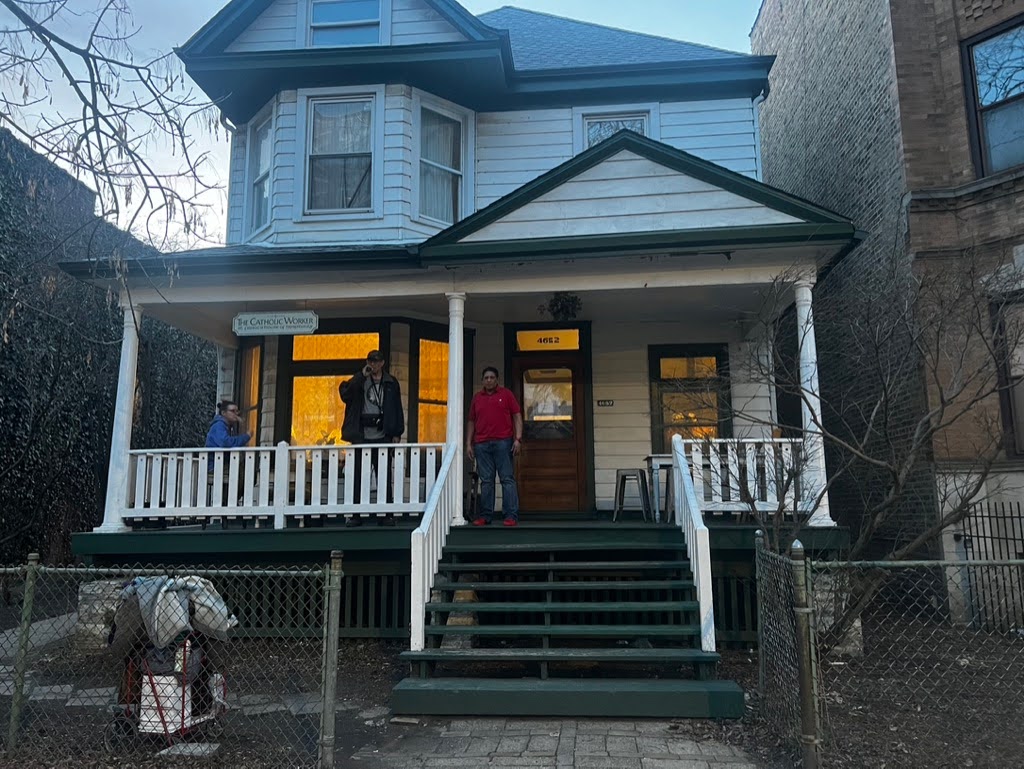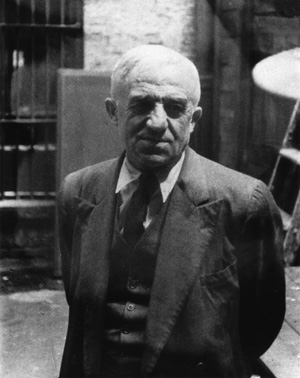Chicago’s St. Francis Catholic Worker House celebrates 50 years of community activism
In the quaint but vibrant neighborhood of Uptown, Chicago, lies a white-shuttered Midwestern home, the St. Francis Catholic Worker House. The green wooden porch bears the marks of time, cracked from the soles that have wandered upon it, still standing as a symbol of resilience and compassion. The sign in the front yard, weathered but unwavering, is reluctant to fade, a true testament to the enduring spirit of the house that has stood for over 50 years.
The St. Francis Catholic Worker House stands as a beacon of hope for the community of Chicago. Amid the towering skyscrapers and the bustling streets, the St. Francis community actively engages in helping individuals who are disenfranchised by systemic injustices. The workers dedicate their lives to helping those who walk up the wooden steps in need of help, and the house gives those in need more than just a warm bed or meal.
Each worker tells a unique story of how they were drawn to the Catholic Worker, but all were drawn to the work by a shared calling to serve the people who have faced adversity. Some are lifelong activists, their passion for social justice driving them to dedicate their lives to the work, while others just stumbled upon this path unexpectedly. Despite their diverse backgrounds and journeys, they have been united by a common purpose: to fully embody the power of compassion and solidarity.
The current composition of the St. Francis House reflects the legacy of its founders, Peter Maurin and Dorothy Day. The house embodies the principles of service and hospitality — principles that Maurin and Day fostered.
The origins of the St. Francis Catholic Worker House digs deep into Maurin and Day’s revolutionary vision. In 1933, Maurin, a French immigrant, and Day, a journalist, founded The Catholic Worker, a newspaper reaching those most affected by the Great Depression. Maurin’s deep understanding of Catholic social teachings educated Day, and together, they began to revolutionize Catholic social justice work. The newspapers called on dockworkers, lawyers and bishops, to make tangible change within the United States, emphasizing that their faith was not limited to just Sunday mornings.
However, Day’s vision extended beyond this. Addressing social issues such as poverty, homelessness and injustice did not originate from grand gestures or lofty speeches; rather, it emerged from the actions of ordinary people.
So, Day and Maurin took these ideas and employed them in their own practice, opening up their first Catholic Worker House in South Bend, Indiana, in 1940. The house, now called St. Peter Claver Catholic Worker, was a product of two students who studied under Maurin and Day, applying their learned Catholic ideologies to real-life situations.
Left: A portrait of Dorothy Day taken in 1934, in the New York World-Telegram & Sun Collection, in the public domain. Right: A portrait of Peter Maurin taken in 1934, from the Marquette University Archive in the public domain.
Almost 100 years later, the Catholic Worker Movement thrives on the same principles: solidarity, preferential option for the poor and subsidiary, which are all foundations cultivated by Day and Maurin.
“The purpose of the newspaper was to make the encyclicals of the church known, teaching on care for the poor, social equity and social justice. These injustices were not being preached in many pulpits,” says Renee Roden, a former Catholic Worker and journalist.
Roden always felt a strong connection to the Catholic Worker movement, particularly with its ties to her alma mater, Notre Dame University, located close to South Bend, Indiana. Day and Maurin would frequently visit the university, speaking in lectures and meeting with professors. Although Roden had not connected to the Catholic Worker movement at the time of her schooling, the idea of building community had remained within her.
As Roden’s work in playwriting and theology took her to New York City, she found it challenging to build connections. She often thought about the Catholic Worker House and its looming presence, especially Day’s house on the Lower East Side. Roden took the leap to reach out to St. Joe’s house. In June of 2020, this marked her first direct engagement with the Catholic Worker Movement, where she immersed herself in roundtable discussions and contributed to the facilitation of tasks such as unloading grocery donations, demonstrating her eagerness to establish a foothold within the organization.

“Catholic Worker, St. Joseph House” by Nick Normal is licensed under CC BY-NC-ND 2.0
Roden’s experience with the St. Joe’s house impacted her and contributed to her writing and theology practices as she made her move to Chicago in August of 2022, where she would come to live in the St. Francis House.
Roden’s work continues to emphasize the core purpose of the movement: to amplify the teachings of the Church through direct action. The emphasis on action is at the heart of the Catholic Worker Movement, where tangible efforts are seen through the deeds of the workers.
“I think my ‘work’ is many different things – building community, living in solidarity with my neighbors, practicing hospitality and the works of mercy,” says Roden.
The St. Francis Catholic Worker House embodies this message, forming a community based on its transformative ethos.
One of the cornerstones of the St. Francis House’s mission is its immediate and direct impact on the community through shelter and nourishment. Every Monday and Saturday night — rain or shine — the volunteers open their doors to feed those in need, offering more than just a warm meal, but a sense of community.
“It doesn’t feel like a lot of soup kitchens or social service agencies where it’s a very transactional experience,” Roden muses, suggesting a deeper connection. “Someone needs help. You’re coming here, I’m helping you. It’s not so much about how I’m helping you as much as it’s about how we’re building a community together.”

Greg, a guest at the house, shares a video with Dan Justman while Daniel Delapava visits with some other folks who stopped by. Volunteers and residents at the St. Francis House, 4652 N. Kenmore Ave. Chicago, prepare their weekly Monday night dinner for the community on Nov. 20, 2023. The house is a home of hospitality in the tradition of the Catholic Worker movement, located in the Uptown neighborhood of Chicago. Since 1974 their community has provided hospitality for single adults experiencing homelessness and housing precarity. (Karen Callaway/Chicago Catholic)
For many of those who come to the St. Francis House, it doesn’t always equate to filling an empty stomach or finding a room; sometimes it’s just about feeling like they belong.
Dani Bodette, a volunteer at the St. Francis House, has filled the living room with her stories, highlighting the profound impact of the simple act of empathy.
Bodette considers herself a “friend of the house.” Meaning, she is not a resident but is still involved in supporting their activities. Bodette helps with house shifts, which includes assessing the house’s hospitality. Additionally, she serves on the house’s fundraising committee, demonstrating her commitment to supporting the house and its mission.
Bodette has observed some of the women at the house indulging in simple acts of self-care, like applying makeup and false eyelashes. To one woman, purchasing dollar store eyelashes to enhance their appearance seems trivial, but the universal truth of it is that everyone wants to feel good about oneself. Bodette was reminded that regardless of their circumstances, everyone deserves to feel beautiful.
This realization led Bodette to a profound insight: the 21st-century version of Washing of the Feet — an act of humility and service — is painting of the nails. Jesus washed the feet of his disciples to demonstrate love and humility. The simple act of self-care or doing each other’s makeup can serve as a powerful reminder that everyone deserves to feel valued.
“Sometimes you gotta remember that everyone deserves that type of care and treatment and it’s fun. Fun isn’t just exclusive to people who have homes. It just humanizes a lot of the media out there that just paints poverty out to be just exclusively suffering.” Bodette says.
Through her experiences, Bodette has learned that true compassion and understanding extend beyond societal norms and expectations. It has become a lesson she will carry as she continues her journey of service and self-discovery at the St. Francis Catholic Worker House.
Dan Justman, a current Catholic worker at the St. Francis House, paints a picture of the daily responsibilities and challenges faced by those serving as a Catholic Worker. According to Justman, the main job of being a Catholic Worker is to be present.
“We never know, really,” Justman explains. “We have a good idea of what days will look like here, but we never know who will show up. We never know what might need to be triaged between some of our hospitality guests. We never know if there will be a sudden donation of food.”
Justman emphasizes the importance of being ready to respond to whatever comes their way. He recalls a phrase used by a long-term Catholic Worker in Denver, describing the role as “consenting to a life interrupted.” This means being prepared to shift focus at a moment’s notice, whether it’s tending to a guest’s needs or coordinating volunteers or food donations.
“The job also looks like coordinating volunteers, coordinating food donations, coordinating our dinners, and what food we have available on the days that we’re open and serving,” Justman elaborates. “It looks like sometimes something akin to case management with some of our hospitality guests. Some of them are largely independent, but sometimes they need pointers, clarifications. They just need to talk.”
In addition to the day-to-day tasks, Justman mentions the broader responsibilities of running the house, such as organizing fundraisers, communications and newsletters. Despite any challenges that may arise, Justman finds fulfillment in the work, recognizing the importance of maintaining a sense of presence while serving his community.
Bodette and Justman tell similar tales from within the old walls, and their stories unfold as a testament to the power of communal support. Justman recalls one resident, who had spent over a year living in a local park. She arrived at the St. Francis House with a cautious heart, scarred by the past disappointments of Chicago social service agencies.
“She’d had negative experiences almost everywhere. When she got here, most of what she said was a continued chorus of ‘Nobody cares, nobody cares, nobody in the world cares, nobody cares.’ That’s really hard because she’s coming here to a place where I care and I don’t want her to think nobody cares,” Justman expresses.
She was wary at first to become involved with the house and their community events, scared that she might be wronged again. Eventually, she found herself being welcomed with not only a bedroom to sleep in but also warmth and open arms from the workers.
“She was about the same age as my mom and for some reason, talking with her, just really reminded me that, like, she could be someone, she could be my mom. When you talk about the Worker, there’s this level of personal care that comes out. It’s like, ‘I care for you so deeply,’” Bodette reflects.
The community embraced her presence, and it became more than just a symbolic gesture. It became a commitment to action.
Within their care, the woman had lost her wallet, where she had kept every personal item. It was a memento of hers. A seemingly small but significant event, the house rallied around her.
Justman guided her through the bureaucratic maze of securing a new I.D., restoring her sense of faith in humanity. After seeing her new I.D., Justman recognized the happy spark, as her bright smile gleamed through the plastic.
The woman’s transformation was palpable. The initial skepticism made way for her to trust again, and she was finally able to share her story, her fears and her dreams with her newfound friends. The community embraced her presence, and it became more than just a symbolic gesture. It became an echo of the commitment to action the house has practiced over the last 50 years.
The transformative impact of the St. Francis Catholic Worker House extends far beyond its walls, resonating deeply within the heart of Chicago. In a city often marked by divisions and disparities, the St. Francis community stands as a testament to the power of direct action.

Volunteers and residents at the St. Francis House, 4652 N. Kenmore Ave. Chicago, prepare their weekly Monday night dinner for the community on Nov. 20, 2023. The house is a home of hospitality in the tradition of the Catholic Worker movement, located in the Uptown neighborhood of Chicago. Since 1974 their community has provided hospitality for single adults experiencing homelessness and housing precarity. (Karen Callaway/Chicago Catholic)
Like many urban cities, Chicago grapples with numerous deep-rooted social issues such as homelessness, poverty and social inequality. The St. Francis House serves as a beacon of hope amid these challenges.
“I think that’s what’s amazing about Catholic Worker houses,” Roden reflects. “You give people a chance just to have good conversations, and people are hungry for that. Everyone is hungry for that. Whether you’re out there or unhoused, we’re all looking for good conversations and good community. I think some of my favorite moments are just hearing someone open up for the first time.”
The story of St. Francis House is not just one of individual transformation but of a collective empowerment of marginalized communities. In Chicago alone, there are three Catholic Worker houses serving the people. One located in North Lawndale, the Emmaus House, generally focuses on providing shelter for 2-3 guests at a time who are transitioning into greater stability, and another one is the Su Casa House, located in the Southwest part of Chicago.
Su Casa serves English- and Spanish-speaking families experiencing housing insecurity, as well as families from Central America seeking asylum in the United States. Originally founded as a shelter for refugees of Central American genocide and civil war, Su Casa has evolved to meet the changing needs of its community, providing a safe and welcoming space for families in crisis. With a capacity to accommodate up to six families at a time, Su Casa offers more than just shelter; it’s a lifeline for those in need.

St. Francis House guests gather on the front porch on a warm day in February. (Photo by Estella Gabor)
As the St. Francis Catholic Worker House commemorates its 50th anniversary, its house stands as a testament to the power of direct action and the commitment of its workers. The Catholic Worker House continues to inspire others to join in the fight against injustice and to create a more compassionate society, carrying on the legacy of its original founders.
“For 50 years, this house has been here. I haven’t been here for all 50 of those years, nobody has been here for all 50, but the continued endurance of the house means something here in Uptown. It resonates with the people it serves,” Justman says, his eyes tracing the lines of the history etched into the walls.
Header Photo by Estella Gabor





NO COMMENT